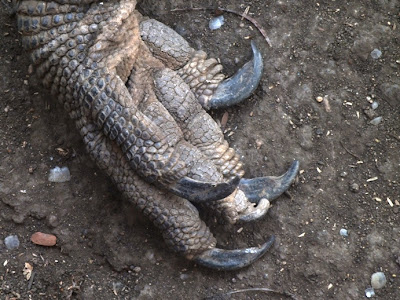My jaunt to Sumba completed I returned to Sape to join the well-trodden path to Labuanbajo. The town constitutes Indonesia's eastern outpost of mass tourism, as people from around the world flock to visit the islands of nearby Komodo national park, home to the eponymous dragons, the largest extant species of lizard in the world and dive in the renowned reefs in the surrounding national marine park. Being the wannabe naturalist that I am I couldn't not go, so I signed up and joined the queue.
 |
| A Komodo dragon in full swing, long, forked tongue out tasting the air. |
The numbers of people and regulated nature of the area mean that visits to Komodo are far from mythical, dangerous, dragon-hunting expeditions. Instead, every morning, a flotilla of wooden boats leaves Bajo and put-puts across the strait to the main islands of Rinca and Komodo, disgorging their tourist cargo to have a leisurely wander for an hour or two, accompanied by a park ranger, armed with a little knowledge and a long stick to protect imprudent visitors who fail to spot the lizards or get too close. For, despite their indolent nature (I saw over a dozen dragons whilst there but only one of them moved more than a metre), they can easily outrun and bring down a man, should they feel inclined to do so. Luckily their preferred prey are buffalo and deer. And you are guaranteed to spot some dragons as the smells of the ranger camp kitchen draw them inexorably in, whilst the shade created by the aforementioned kitchen also provides a great place to laze through the midday heat. There are also females guarding their nests along side the main trails, immobile during their three-month vigil (immobile that is until you start poking around in the nest - not something I was going to attempt). I could understand the sloth. It's the height of the dry season and the islands have become marbled black and yellow from the exposed rock and grass dried to golden straw by the unrelenting, tropical sun. Streams have disappeared and the only water that remains is in the form of a few, stagnant puddles. Quite frankly I wouldn't want to be walking around for too long in the oppressive heat either.
 |
| The dry season is in full swing on the Komodo islands, leaving them parched and barren. |
And although the dragons' passivity didn't conjure images of ferocious, merciless hunters it did allow me to get relatively close and observe the tools of their trade: their long, forked tongue that helps them scent their prey from several kilometres away; their strong jaws dripping septic saliva that helps kill animals that have been bitten; and sharp, curved claws that can tear through flesh with the greatest of ease. Formidable, and elegantly menacing, predators. Nature may be red in tooth and claw, but no matter how She looks She's invariably beautiful.
 |
| You really wouldn't want to get on the wrong side of those claws. |
2 comments:
How was "Septic Saliva" never a heavy-metal band name?
Looks like a cool trip, especially if already on the way out to or back from Flores.
Ha ha, maybe I should trademark the name - perhaps I could earn some money to help fund the trip!
It's definitely a worthwhile excursion, although it's far from being a "proper" nature encounter. Still, they're magnificent animals, and you've just got to go see the biggest whatever it happens to be if you can. Unfortunately it's rather pricey so I didn't do the 2-day package. (Also there's some nice corals and fish if you like snorkelling.)
Post a Comment